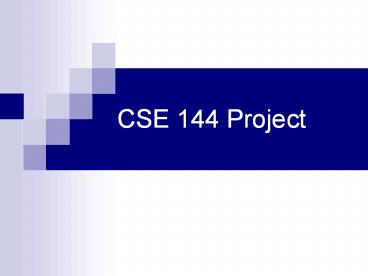CSE 144 Project - PowerPoint PPT Presentation
Title:
CSE 144 Project
Description:
KL: any pair of unlocked components valid FM: only allow moves fulfilling area constraints ... Unlocked components. Always choose component in the highest ... – PowerPoint PPT presentation
Number of Views:16
Avg rating:3.0/5.0
Title: CSE 144 Project
1
CSE 144 Project
2
Overall Goal of the Project
- Implement a physical design tool for a two-row
standard cell design
0
5
3
1
2
4
3
Problems to be resolved
- Positions of components
- Which row to place each component Partitioning
- The relative position of components in each row
Placement - Interconnect between components Routing
4
What to optimize?
- In partitioning minimize the number of
interconnects between partitions (rows) - In placement minimize the overall horizontal
length of interconnects - In routing fulfill the geometrical constraints
--- wires in the same directions should not
overlap
5
Input Specification
- Matrix form circuit model
- First line the number of components, N
- The following N lines the output-input
connections between components - A non-zero entry Aij denotes a connection between
components i and j - The value of Aij denotes the pin number of i
- Last line the size of each components
6
Output Specification
Partitioning Placement
- Routing
- Position of pins connected by each net
- Leftmost and rightmost boundaries of each nets
- Channel track occupied by each net
7
Part 1 Partitioning
- Goal minimize the number of interconnects
crossing the two rows - Constraints partition size should stay within a
tolerance window - The tolerance bound is the size of the largest
component - floor(V/2 - Cmax) lt A lt ceiling( V/2
Cmax)
8
Fundamental Ideas
- The flow of FM algorithm is the same as KL
algorithm - Two differences
- KL component swap per tentative move FM one
component per tentative move - KL any pair of unlocked components valid FM
only allow moves fulfilling area constraints
9
Algorithm
- Initial partitioning (subject to area
constraints) - Gain calculation (same equations as in KL)
- Move and lock the component with highest gain,
which satisfies area constraints (one component
per tentative move). Update gains. - Repeat moving until no one can be moved
- Make permanent all the movements up to and
including the move giving the highest
accumulative gain - Unlock all components and repeat until no
improvement can be obtained
10
How to improve efficiency?
- Gain updating technique
- Locked components neednt be updated
- Components unconnected to the ones being moved
neednt be updated - Use efficient data structure
- Three data structure candidates provided
11
Data Structure 1 Linked List
Gain stamps
Unlocked components
Gmax
Current max gain
3
Comp 5
Comp 0
NIL
2
Comp 1
Comp 3
NIL
1
0
Comp 4
NIL
-1
- Always choose component in the highest linked
list for tentative move - Gain updating corresponds to changing the
position of components in the linked lists
-2
-3
-Gmax
12
Data Structure 2 Gain Matrix
Components
c4
c0
c2
c3
c5
c1
1
1
3
- Always choose component in the highest row that
contains 1-entries - Gain updating corresponds to changing the
positions of 1-entries in the gain matrix
1
1
2
1
Gain value
1
0
1
-1
-2
-3
13
Data Structure 3 Gain Array
Components
c1
c2
c3
c4
c5
c0
3
2
-1
2
0
3
Gain
- Gain updating corresponds to changing the values
of the gain array elements
14
Implementation Requirement
- Analyze the suggested data structures in terms of
- Primarily computational efficiency
- Secondarily space efficiency
- Implement the most efficient one you think
- Provide a detailed description of your analysis
in your turn-in































